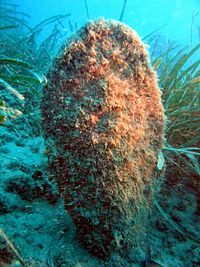Chiara Vigo dives up to 17 yards deep and into a network of caves off the coast of Sardinia to harvest sea silk from the Pinna Nobilis, or pen shell, a giant Mediterranean mollusk that measures a yard in length and which secretes a protein that, on contact with sea water, hardens into a silken filament called byssus.

Pinna nobles can grow to more than three feet long
The clams secrete this protein to attach themselves to rocks or the sea floor. The byssus of the pen shell makes sea silk, the world’s rarest thread.
Chiara Vigo, according to the BBC, is the only person alive who knows how to spin this clam fluid into a golden thread. She dives by the light of the moon with the Italian Coast Guard watching as protective measure for her and the rare clams. Since 1992, the European Union has had a blanket ban on harvesting or harming the pen shell mollusks. She says a prayer before each dive and adheres to a so-called ancient, sacred “Sea Oath” that prevents sea silk from being bought or sold.
She may dive 100 times to produce a single ounce of the fibers she harvests by trimming the byssus from each bivalve with a tiny scalpel. After removing the byssus, she pushes the clams back into the mud. She claims her method of harvesting is like giving the clams a haircut and doesn’t harm them. This allows her to continue to harvest this fiber. She claims her family has been harvesting the fiber this way for over 1000 years.
These beard-like growths can be up to six inches in length. The filaments are first soaked in sea water and then in fresh water. Next, they are teased with a spiky comb and then spun with a spindle. Lemon juice is used to brighten and clarify the thread which is anywhere from bronze to blonde in color. The fibers are up to three times finer than human hair.
About 60 examples of sea silk garments persist in museum collections around the world, most dating from the last few centuries. Since the ban on harvesting the byssus, it is too labor intensive to collect enough fiber to make a proper cloth. Vigo, who doesn’t accept payment for sea silk, sometimes uses it in the embroidery of a child’s christening gown.